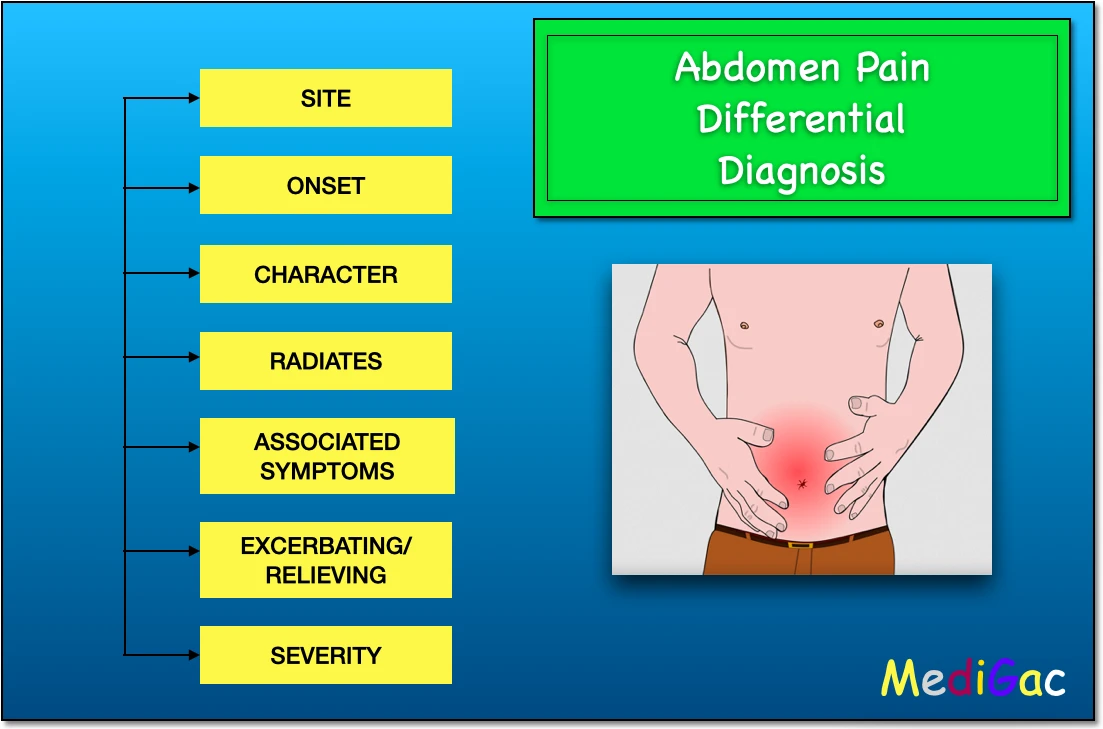
Abdominal pain can occur due to various causes, here in this post we have discussed all possible causes of the abdominal pain.
We are dividing the abdominal pain by nine characters
Mnemonics – SOCRATES
I. S(Site) – What is the source of the discomfort ?
There are many examples where different sites acts as different pain :
- Somatic Pain – Conducted by the intercostal nerves from parietal peritoneum and abdominal wall.
- Above the umbilicus – This occurs when the pain arises from foregut structures like stomach, liver, pancreas and biliary system.
- Pain in the lower abdomen – This arises from the hindgut structures like the colon.
II. O(Onset) – What were they doing when the pain started ?
- Sudden onset abdominal pain -This can suggest a ruptured abdominal aneurysm or mesenteric infarction, hollow viscus perforation due to colorectal cancer and peptic ulceration.
- Sudden pain with abdominal obstruction – when distortion of the sigmoid colon occurs.
III. C(Character) – What does it feel like to be in pain?
- Colicky Pain – This type of pain occurs for very short times likely for seconds or minutes. And this originates from the obstruction of large and small intestine. Sometimes uterine pain also felt during labour.
IV. R(Radiates) – Is there any other place where the pain can be felt ?
- Central upper abdominal pain felt at the backside of the upper abdomen – This suggests Pancreatitis, and this can be releieved for short time by sitting forward.
- Renal Colic – In this scenario the pain radiates from loin to groin and genitalia.
- Central abdominal pain shots to the right iliac fossa – This occurs in acute appendicitis
- Combined severe back pain and abdominal pain – This mainly suggests the ruptured or dissecting abdominal aortic aneurysm.
- Diaphragmatic irritation – In acute cholecystitis, this irritation occurs which radiates from the right hypochondrium to the shoulder or inter scapular region.
V. A(Associated Symptoms) – If any other associated symptoms present like nausea, vomiting, diarrhoea etc.
- Breathlessness or palpitation – This mainly indicates the non-alimentary causes.
- Altered bowel habit – This may suggests pain due to irritable bowel syndrome and colorectal cancer.
- Hypotension and Tachycardia – This can occurs due to intra-abdominal sepsis or bleeding.
VI. T(Time/Duration) – For how much time, they are having the pain ?
- Pain lasting for hours or days – This mainly suggests an inflammatory disorder, like acute appendicitis, cholecystitis etc.
VII. E(Excerbating/Relieving factors) – Is there any factor which makes the pain better or worse ?
- Pain getting worse after coughing – This mainly suggests inflammation.
- Lying down – To get the relieve from the pain patient may lie down, this acts as relieving factor.
VII. S(Severity) – Getting an primary pain score
- Analgesia – Severe pain if poorly received by the analgesia then it suggests bowel infarction, and ruptured abdominal aortic aneurysm. And when the pain gets rapidly eased then this can be a case of pancreatitis or peritonitis.